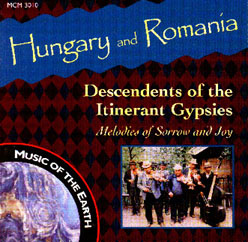 |
Hungary and Romania: Descendants of the Itinerant Gypsies: Melodies of Sorrow and Joy
|
| Melodies
of Sorrow and Joy is a re-release of field recordings of songs and instrumental
pieces performed by Gypsy (Rom) musicians from Hungary and Romania and originally released
in Japan. The disc is divided into two halves, each recorded by a different
researcher, with the pieces in each half grouped together on the recording by geographical
region. As a result, the CD and its accompanying notes seem like two separate
projects, which they originally were.
|
|
|
The first half of the disc, recorded in Hungary, consists of sixteen tracks of vocal music. All of the songs are examples of either thekhelimaski dyili, a rhythmic, sung dance, (Audio 1) or the meselaki dyli, a slow song with free rhythm (Audio 2). Brief, paraphrased translations are provided for each of the slow songs, while no translations are provided for the dance songs. |
| The
generous number of examples of both song types provides a good introduction to these
genres, and a welcome opportunity for comparison of styles between various singers and
different villages. The meselaki dyli selections recorded in Gyngys Village, for
example, are sung in heterophonic style by a group of men's and women's voices, and
provide an important contrast to the meselaki dyli examples of Piricise Village,
which are performed by solo voices.
|
|
|
The second half of the disc provides a more diverse sampling of instrumental styles from the Carpathian Mountain region, including a Csardas, a funeral piece, several varieties of men's dances, (Audio 3) a wedding march, (Audio 4) and couples' dances. With the exception of one piece played by a violin/gardon (cello-like stringed instrument) duo, the instruments playing on each track are not listed. |
Multicultural Media is to be commended for releasing these valuable
recordings and for translating the original notes. The notes however, and the format in
which they are presented, are confusing and perhaps require more editorial comment than
the brief disclaimer at the back of the booklet which describes both the difficulties of
transliteration as well as the diverse professional backgrounds of the researchers.
Several problems are apparent. Some tracks include no annotation other than the name of
the genre. None of the songs or instrumental pieces are given a title, and none of the
performers appearing in the recording or the accompanying photographs are identified or
credited. Although these recordings were originally released in 1992, with the songs from the first half recorded in the 1980s, the photographs in the accompanying booklet are from 1963, leaving some question as to when the rest of the field recordings were made. Again, some historical context for the recordings and the notes would be a welcome addition. Difficulties in presentation aside, the
recordings and the notes too, contain much that should delight and interest many
listeners, especially newcomers to Rom music of this region. The song selections are
compelling performances representing a variety of individual and regional styles, and the
instrumental tracks provide documentation of some fine examples of solo violin and
ensemble playing from the Carpathian Mountains. Although the annotations to the individual
selections are somewhat incomplete, the notes provide a fine history of Gypsy instrumental
music in Hungary, and good, informative general descriptions of the song
genres. Suzanne Camino is a doctoral candidate in the ethnomusicology program at the University of Michigan. She is currently researching songs of emigration and exile among Albanian communities in the United States. Her past research has focused on Albanian polyphonic singing and Bektashi Sufi chanting. |
|